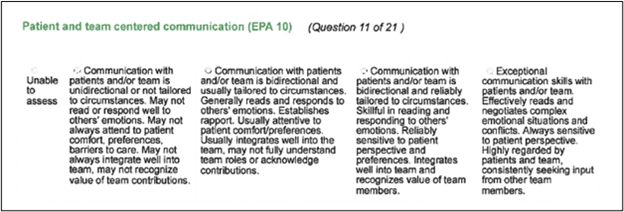[ad_1]
It’s been shown that patients can benefit from a satisfying medical experience and the actual clinical treatment. The satisfying medical experience in and of itself leads to trust, follow-through, and health improvements.
Medical school is the optimal time to learn how to deliver a great patient experience. In med school, one develops formative views on the culture of medical practice. Knowing this, we looked at an institution that excels in teaching students to be empathetic caregivers. (Note: we have no financial or other involvement with the school.)
East Carolina University’s Brody School of Medicine ensures its students develop compassion. It doesn’t crack the US News & World Report Top 50 medical schools — large, well-funded places like Johns Hopkins, Harvard, Stanford, and Columbia top that list. If judged by career inventions and medical advances, they produce the most technically adept physicians. They excel in student MCAT scores and academic achievements, awards granted, research excellence, grant funding, and technical teaching excellence. The drawback of their sweeping excellence is that they may not be able to focus with their time, attention, and money on teaching students how to deliver a deeply caring patient interaction.
We believe that if a school is going to drive changes to improve the patient experience, it needs to focus on advancing change in four areas, namely its:
- Communications, so it attracts the right applicants
- Application and admissions process
- Curriculum, and
- Assessments and evaluations of students
Delivering a compassionate patient experience needs to be a priority of medical education, and Brody appears to do this more comprehensively than other schools. It has positioned itself in the family- and primary-care physician segment and consistently ranks (by The American Academy of Family Physicians) as the #1 or 2 school in producing family physicians. It’s ranked in the top ten percent in the country in the combination of primary care and serving rural and under-served populations.
We examined the Brody way in each of the four areas above.
Communications and marketing
Brody knows its mission and communicates consistently that it’s the right school for North Carolina residents who want to focus on the compassionate delivery of medicine within and among rural and under-served populations. Here’s a sample of communications, showing it knows who it is:
The Brody School of Medicine at East Carolina University is nationally recognized for preparing primary care physicians who practice in medically underserved communities. All those admitted are North Carolina residents, and the majority of its graduates practice primary care in North Carolina.
Admissions
Brody seeks and evaluates applicants on their family medicine capabilities. In an article, the president of the American Academy of Family Physicians said, “Brody is the quintessential example of how you recruit these young people to the specialty of family medicine.”
Costing substantially less than most schools, it draws applicants for whom the high cost of med school might otherwise be prohibitive. At Brody, 13 percent of students have medical debt over $200K compared to 37 percent nationally, and Brody students graduate with an average of 26 percent less debt than their peers elsewhere. This increases the likelihood they’ll choose primary care, which pays less than specialties. The low cost allows graduates to choose a medical career based on their hearts, not pocketbooks — the idea of “love” in medicine starts with choosing a specialty you love versus what will pay best.
The school vets candidates based on experiences, references, interviews, and character, stating, “… we strive to use numerical data (such as GPAs and MCAT scores) more as a ‘safety gauge’ than as an absolute measure of worthiness.”
Character elements show up more often and more prominently in school communications than do items like MCAT scores and grades. Compared to larger schools, the language Brody uses is more compassionate, relatable, and human.
Our scan of elite schools’ communications shows they more often use technical, achievement-based words/phrases like: excellence, accomplishment, talents, instructions, policies, deadlines, essays, academics, MCAT, powerful, science, technologies, excel, research, committee, competence.
Meanwhile, Brody more often makes use of relationship-based, compassion-oriented words/phrases like:
rich, rewarding, collegial, relationships, take time, call us, improve, prepare, know all of their classmates, journey, shared experience, counseling, patient care, teaching, curiosity, enjoy, experience, success, enriching.
We infer they attract and evaluate their candidates based on their ability to embody those words.
Curriculum
The Brody curriculum emphasizes a collegial classroom culture. One student said, “I was amazed by how little pride [i.e., excessive ego] there was, and there are these awesome doctors who really focus on the mission to serve the community.”
The curriculum is geared towards teaching the delivery of a strong patient experience. Brody redesigned its curriculum to “promote the development of leadership skills, professionalism, ethics, humanism and service to others.”
Another core competency that Brody students must develop to advance through school is interpersonal and communication skills. They must “demonstrate effective listening, verbal and written communication skills that result in the effective exchange of information and collaboration with patients and families while providing patient-centered care.”
More specifically, to earn high marks, Brody students must communicate compassionately, develop therapeutic relationships across backgrounds, engage in shared decision making, listen with empathy and respect, collaborate, and focus on patient- and population-centered care.
Assessments and evaluations
Brody professors evaluate clinical performance by answering questions about students’ observed behaviors including a patient-centered skillset. Here’s an example — a less skilled mark on the left side, a more skilled mark on the right:


Source: Brody School of Medicine
In summary, Brody has a theme of patient-centeredness in its communications, admissions, curriculum and assessments. The school has the right stuff for helping med students develop compassionate caretaking skills.
Although its model merits emulation nationally, its mission is decidedly local — to increase the supply of primary care physicians serving the state, improve the health status of eastern North Carolina’s citizens, and enhance access of minority and disadvantaged students to a medical education.
Brody is one great example of a medical school that is doing an excellent job training patient-centered caretakers in medicine.
Joe Mandato is a venture capitalist investing in the life sciences and a faculty lecturer in biodesign at Stanford University. He is former CEO, and current and former board member, of a number of health care and medical device organizations. He can be reached on Twitter @josephmandato.
Ryan Van Wert is CEO, Vynca Health, and a critical care physician, clinical assistant professor in the department of medicine at Stanford University, and associate director of Stanford’s Byers Center for Biodesign. He can be reached on Twitter @ryanvanwertmd.
Image credit: Shutterstock.com
[ad_2]
Source link



